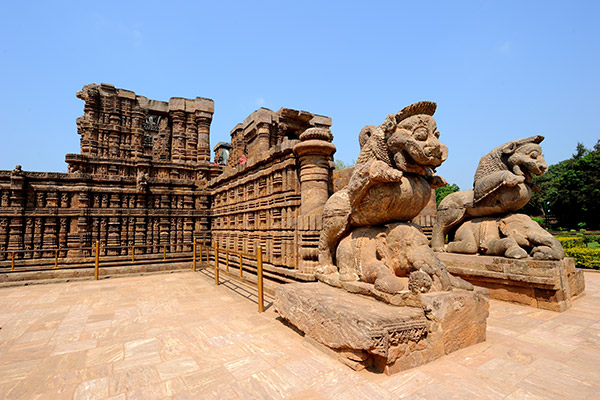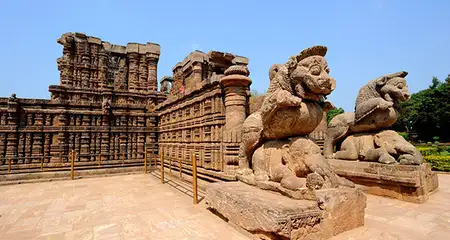Nestled on the east coast of the Bay of Bengal, the Sun Temple in Konark is one of the most spectacular sights that await you in Odisha. The 13th-century temple complex is designed as a colossal ornamented stone chariot led by seven stone horses and is dedicated to Surya, the Sun God. Also known as the Black Pagoda, the temple is an incredible masterpiece of architecture that attracts tourists, historians, and archeologists from all over the world. It is located a couple of hours’ drive from some of the major cities in Odisha, such as Bhubaneshwar and Cuttack.
Want to know more about this glorious heritage structure that has been declared a UNESCO World Heritage Site? In this blog, we have compiled all the details about Konark Sun Temple, including its history, architecture, timings, visitor info, and other details.
Konark Sun Temple Information:
| Location | Konark, Odisha |
| Type | Temple |
| Status | UNESCO World Heritage Site |
| Also known as | Surya Devalaya, Black Pagoda |
| Distance from Major Cities | Puri (34 km); Bhubaneshwar (67 km); Cuttack (82 km) |
| Timings | 6:00 am to 8:00 pm; every day |
| Entry Fee | ₹ 30 for Indians; ₹ 500 for foreigners |
| Konark Dance Festival Entry Passes | ₹ 400 per person |
| Photography | Non-commercial photography is free |
| Built in | 1250 AD |
| Dedicated to | Surya or The Sun God |
| Architectural Style | Odisha style of architecture or Kalinga architecture |
| Commissioned by | King Narasimhadeva I of the Eastern Ganga Dynasty |
| Materials Used | Chlorite, Laterite, and Khondalite Rocks |
| Area covered | 2 acres |
| Other Attractions | Museum, Light and Sound Show |
Konark Sun Temple: History
Konark Sun Temple dates back to 1250 AD. The construction of the temple is credited to King Narasimhadeva I, a warrior and monarch of the Eastern Ganga Dynasty. This giant temple was built near an old temple dedicated to Surya, the Sun God. Inscriptions dating back to the era indicate that the sculpture in that older temple was re-consecrated into the new temple. It is believed that this elaborately carved temple was built over a period of 12 and with the help of 12,000 artisans.
Several ancient texts eulogize the marvelous beauty of Konark Sun Temple, which was an active place of worship until at least the middle of the 16th century. However, the grand structure wasn’t able to escape the damage and destruction caused by time. It is not clear as to what caused its large-scale destruction to the extent that the main temple structure was completely ruined. Some historians suggest that the temple was damaged due to natural causes while some others imply that the temple was intentionally damaged by Muslim invaders, mainly Kalapahad, a general of Gour Sultanate. Whatever be the cause, the temple suffered extensive damage between 1556 and 1800.
During the last part of the 18th century, an ornamented pillar called Aruna Stambha was relocated from Konark Sun Temple to the famous Jagannath Temple in Puri, which stands there to this day. The existing portion of the temple was partially restored by the archaeological teams of the British-era. The temple was declared a UNESCO World Heritage Site in 1984.
Konark Sun Temple Architecture
The Sun Temple in Konark exhibits the traditional Odisha style of architecture, also known as Kalinga architecture, on a grand scale. It is designed as a massive chariot mounted on 12 pairs of intricately carved giant stone wheels that are drawn by a set of seven mighty stone horses. The temple is built with such a fine slant towards the east that the first rays of the rising sun illuminate the main entrance. This main entrance is ornamented with two huge stone lions standing on both sides. Both these lions are shown as trampling an elephant and a man beneath.
The temple complex spreads over 26 acres of land. Three kinds of stones were used in its construction, namely Chlorite, Laterite, and Khondalite rocks. The original temple consisted of the main sanctuary, called Bada Deul or Rekha Deul, which was surrounded by other smaller structures. In front of the main sanctuary stood another smaller sanctum called the Bhadra Deul or the assembly hall of the people. It is believed that the main sanctuary had a height of around 225 feet, but not much remains of that structure.
What survived through the ages is the smaller sanctum, which is a magnificent structure in itself. It has a height of around 100 feet and is adorned with exquisite stone carvings all over. This sanctum is celebrated for its intricate artwork, themes, and iconography that include erotic depictions as well, much like the Khajuraho Temple in Madhya Pradesh. Apart from this smaller sanctum, a few other structures and sanctums have also survived. These include the Nata Mandir or the dancing hall, the nine planets temple, and the kitchen or Bhoga Mandapa.
Konark Sun Temple: Today
Today, the Sun Temple of Konark stands as a fine example of the architectural brilliance of a bygone era. No wonder, the temple is one of the most visited structures in Odisha and is a top tourist destination. It is estimated that more than 4,000 people visit the temple every day.
Every year, the Konark Dance Festival is organized in the first week of December in the backdrop of the Sun Temple. One of the famous dance festivals in India, it is held for five days and attended by many celebrated dancers from across India. A light and sound show is also held at the temple premises every evening.
Things to See in the Konark Sun Temple Complex
The temple complex has several structures and architectural figures scattered within it. The top things to see in Konark Sun Temple include:
- The main existing temple structure
- The giant carved wheels, each of which is a sundial
- Mayadevi Temple, which is believed to be the ancient Sun Temple that was incorporated when this new temple was built
- Vaishnava Temple that contains the sculptures of various Hindu deities like Varaha, Balarama, and Vamana-Trivikrama.
- Bhoga Mandapa or the kitchen containing water cisterns, cooking floor, ovens, and demarcated areas for grinding grains and spices
- Nata Mandir or the dancing hall, full of carved images of dancers and musicians
- The Nava Graha or Nine Planets Temple
- Intricately carved figures of elephants, horses, and lions at the entrance
- Various images of mythical creatures, musicians, dancers, and erotic sculptures
Konark Sun Temple Light and Sound Show
A major attraction at the Sun Temple is the amazing light and sound show held in the evenings. Counted among the best light and sound shows in India, it recounts the historical and religious significance of the temple in a visually appealing manner. Wireless headphones are provided to the audience and the shows are held twice daily. Note that the shows are held only if there is an audience of at least 25 people.
- Duration: 40 mins
- Language: English, Hindi, Oriya
- Timings*:
- March to October – 7:30 pm to 8.10 pm; 8:20 pm to 9:00 pm
- November to February – 6:30 pm to 7:10 pm; 7:30 pm to 8:10 pm
- *No shows on Mondays
- Tickets: ₹ 50 per person
Konark Archeological Museum
If you are a history buff, make sure to visit the museum situated near the Sun Temple. The museum, which was established in 1968, is currently being maintained by the Archeological Survey of India (ASI). It houses a number of artifacts and objects excavated from the Konark site and some of the structures and parts that were fallen from the Sun Temple. It has about 260 items, including manuscripts, paintings, and sculptures, displayed in four galleries.
- Konark Museum Timings: 10:00 am to 5:00 pm; closed on Fridays
- Entry Fee: ₹ 5 per person (subject to change)
Lesser Known Facts about Konark Sun Temple
- The term Konark is a combination of two Sanskrit words – Kona meaning angle or corner and Arka meaning the Sun.
- If the Sun Temple is watched from the inland during the sunrise and sunset hours, it seems as if the chariot-shaped temple is emerging out of the sea carrying its deity, the Sun.
- Each of the giant wheels of the Sun Temple is a sundial that can help to estimate time precisely to a minute.
- The seven horses of the Sun Temple represent the seven days of the week.
- Konark Sun Temple is regarded as the third link of Odisha’s golden triangle comprising of the Jagannath Temple in Puri and the Lingaraj Temple in Bhubaneswar.
- The temple was built close to the Chandrabhaga River which used to flow within a mile of it. However, over the years, the river has changed course and no longer flows near the temple now.
- The monolithic Aruna Stambha that was relocated to the Jagannath Temple in Puri is dedicated to the charioteer of the Sun god called Aruna.
- The new ten rupee note issued by RBI in 2018 features the Sun Temple on its rear side.
Attractions near the Sun Temple in Konark
- Konark Archeological Museum (850 m)
- Chandrabhaga Beach (3.1 km)
- Kuruma Village (7.9 km)
The Sun Temple in Konark is a majestic sight to behold, to say the least. Its grandeur and brilliance is something that you need to experience firsthand. Why not plan a trip to Konark and explore this wondrous monument? There might not be many accommodation options around Konark, but you can book your rooms in the hotels in Bhubaneshwar as it is one of the major cities located close to the temple.



























